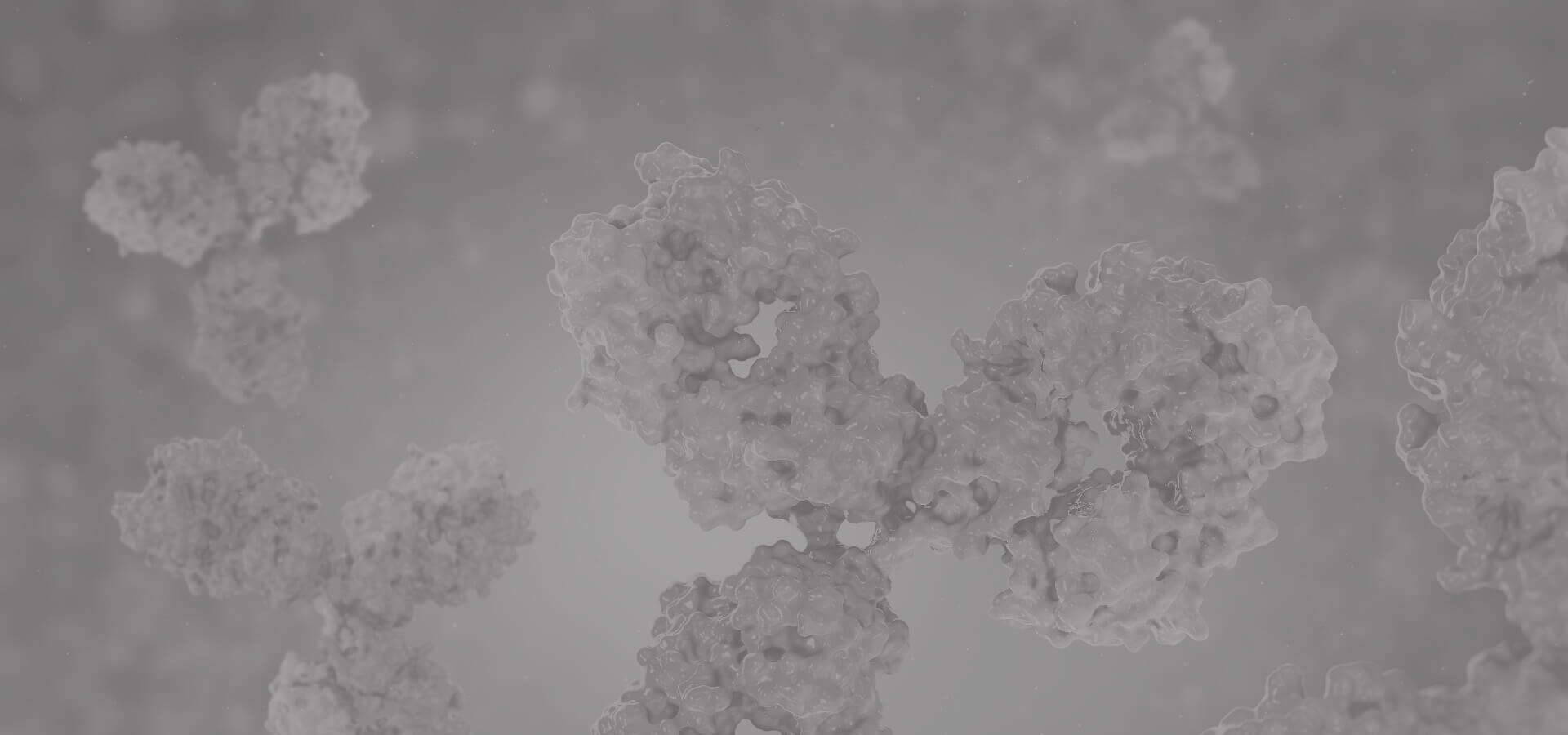LAMB1
Laminins, a family of extracellular matrix glycoproteins, are the major noncollagenous constituent of basement membranes. They have been implicated in a wide variety of biological processes including cell adhesion, differentiation, migration, signaling, neurite outgrowth and metastasis. Laminins are composed of 3 non identical chains: laminin alpha, beta and gamma (formerly A, B1, and B2, respectively) and they form a cruciform structure consisting of 3 short arms, each formed by a different chain, and a long arm composed of all 3 chains. Each laminin chain is a multidomain protein encoded by a distinct gene. Several isoforms of each chain have been described. Different alpha, beta and gamma chain isomers combine to give rise to different heterotrimeric laminin isoforms which are designated by Arabic numerals in the order of their discovery, i.e. alpha1beta1gamma1 heterotrimer is laminin 1. The biological functions of the different chains and trimer molecules are largely unknown, but some of the chains have been shown to differ with respect to their tissue distribution, presumably reflecting diverse functions in vivo. This gene encodes the beta chain isoform laminin, beta 1. The beta 1 chain has 7 structurally distinct domains which it shares with other beta chain isomers. The C-terminal helical region containing domains I and II are separated by domain alpha, domains III and V contain several EGF-like repeats, and domains IV and VI have a globular conformation. Laminin, beta 1 is expressed in most tissues that produce basement membranes, and is one of the 3 chains constituting laminin 1, the first laminin isolated from Engelbreth-Holm-Swarm (EHS) tumor. A sequence in the beta 1 chain that is involved in cell attachment, chemotaxis, and binding to the laminin receptor was identified and shown to have the capacity to inhibit metastasis.
Full Name
LAMB1
Function
Binding to cells via a high affinity receptor, laminin is thought to mediate the attachment, migration and organization of cells into tissues during embryonic development by interacting with other extracellular matrix components. Involved in the organization of the laminar architecture of cerebral cortex. It is probably required for the integrity of the basement membrane/glia limitans that serves as an anchor point for the endfeet of radial glial cells and as a physical barrier to migrating neurons. Radial glial cells play a central role in cerebral cortical development, where they act both as the proliferative unit of the cerebral cortex and a scaffold for neurons migrating toward the pial surface.
Biological Process
Animal organ morphogenesisManual Assertion Based On ExperimentIBA:GO_Central
Basement membrane assemblyManual Assertion Based On ExperimentIBA:GO_Central
Cell adhesionManual Assertion Based On ExperimentTAS:HGNC-UCL
Cell migrationManual Assertion Based On ExperimentIBA:GO_Central
Endodermal cell differentiationManual Assertion Based On ExperimentIEP:UniProtKB
Neuron projection developmentManual Assertion Based On ExperimentIDA:UniProtKB
Neuronal-glial interaction involved in cerebral cortex radial glia guided migrationManual Assertion Based On ExperimentIMP:UniProtKB
OdontogenesisManual Assertion Based On ExperimentIDA:UniProtKB
Positive regulation of cell migrationManual Assertion Based On ExperimentIDA:UniProtKB
Positive regulation of epithelial cell proliferationManual Assertion Based On ExperimentTAS:HGNC-UCL
Substrate adhesion-dependent cell spreadingManual Assertion Based On ExperimentIDA:BHF-UCL
Tissue developmentManual Assertion Based On ExperimentIBA:GO_Central
Basement membrane assemblyManual Assertion Based On ExperimentIBA:GO_Central
Cell adhesionManual Assertion Based On ExperimentTAS:HGNC-UCL
Cell migrationManual Assertion Based On ExperimentIBA:GO_Central
Endodermal cell differentiationManual Assertion Based On ExperimentIEP:UniProtKB
Neuron projection developmentManual Assertion Based On ExperimentIDA:UniProtKB
Neuronal-glial interaction involved in cerebral cortex radial glia guided migrationManual Assertion Based On ExperimentIMP:UniProtKB
OdontogenesisManual Assertion Based On ExperimentIDA:UniProtKB
Positive regulation of cell migrationManual Assertion Based On ExperimentIDA:UniProtKB
Positive regulation of epithelial cell proliferationManual Assertion Based On ExperimentTAS:HGNC-UCL
Substrate adhesion-dependent cell spreadingManual Assertion Based On ExperimentIDA:BHF-UCL
Tissue developmentManual Assertion Based On ExperimentIBA:GO_Central
Cellular Location
Secreted, extracellular space, extracellular matrix, basement membrane
Major component.
Major component.
Involvement in disease
Lissencephaly 5 (LIS5):
An autosomal recessive brain malformation characterized by cobblestone changes in the cortex, more severe in the posterior region, and subcortical band heterotopia. Affected individuals have hydrocephalus, seizures, and severely delayed psychomotor development.
An autosomal recessive brain malformation characterized by cobblestone changes in the cortex, more severe in the posterior region, and subcortical band heterotopia. Affected individuals have hydrocephalus, seizures, and severely delayed psychomotor development.
View more
Anti-LAMB1 antibodies
+ Filters
 Loading...
Loading...
Target: LAMB1
Host: Mouse
Antibody Isotype: IgG2a
Specificity: Human
Clone: CBYJL-1108
Application*: E, WB, IH
Target: LAMB1
Host: Mouse
Antibody Isotype: IgG1, κ
Specificity: Human
Clone: CBYJL-1106
Application*: E, IF, IP, WB
Target: LAMB1
Host: Mouse
Antibody Isotype: IgG2a
Specificity: Human
Clone: 2D9G5
Application*: WB
Target: LAMB1
Host: Mouse
Antibody Isotype: IgG1, κ
Specificity: Human
Clone: CBYJL-1105
Application*: E, WB, IF, IP
Target: LAMB1
Host: Rat
Antibody Isotype: IgG1
Specificity: Human
Clone: CBYJL-1104
Application*: P
Target: LAMB1
Host: Mouse
Antibody Isotype: IgG1
Specificity: Human
Clone: DG10
Application*: C, E, WB
Target: LAMB1
Host: Mouse
Antibody Isotype: IgG1
Specificity: Human
Clone: CBYJL-1102
Application*: WB, P
Target: LAMB1
Host: Mouse
Antibody Isotype: IgG1
Specificity: Human
Clone: 5G14
Application*: IH, WB
Target: LAMB1
Host: Mouse
Antibody Isotype: IgG1
Specificity: Human
Clone: 2Q594
Application*: IP, WB
Target: LAMB1
Host: Mouse
Antibody Isotype: IgG2a
Specificity: Human
Clone: CBYJL-1101
Application*: E, IH, WB
Target: LAMB1
Host: Rat
Antibody Isotype: IgG1, κ
Specificity: Human, Hamster, Mouse, Pig
Clone: CBYJL-1100
Application*: IF, IH, IP, WB
Target: LAMB1
Host: Mouse
Antibody Isotype: IgG
Specificity: Human
Clone: CBT840
Application*: WB, P, IF, E
Target: LAMB1
Host: Mouse
Antibody Isotype: IgG2a
Specificity: Human
Clone: CBT2989
Application*: IH
Target: LAMB1
Host: Mouse
Antibody Isotype: IgG1, κ
Specificity: Chicken, Guineafowl, Quail
Clone: 31-2
Application*: IF, IH, IP, WB
More Infomation
Hot products 
-
Mouse Anti-ATP1A2 Recombinant Antibody (M7-PB-E9) (CBMAB-A4013-YC)

-
Mouse Anti-8-oxoguanine Recombinant Antibody (V2-7719) (CBMAB-1898CQ)

-
Mouse Anti-BRD3 Recombinant Antibody (CBYY-0801) (CBMAB-0804-YY)

-
Rat Anti-CD300A Recombinant Antibody (172224) (CBMAB-C0423-LY)

-
Mouse Anti-CCNH Recombinant Antibody (CBFYC-1054) (CBMAB-C1111-FY)

-
Mouse Anti-BZLF1 Recombinant Antibody (BZ.1) (CBMAB-AP705LY)

-
Mouse Anti-CORO1A Recombinant Antibody (4G10) (V2LY-1206-LY806)

-
Mouse Anti-ALB Recombinant Antibody (V2-180650) (CBMAB-A2186-YC)

-
Mouse Anti-CGAS Recombinant Antibody (CBFYM-0995) (CBMAB-M1146-FY)

-
Mouse Anti-BRCA2 Recombinant Antibody (CBYY-0790) (CBMAB-0793-YY)

-
Rat Anti-4-1BB Recombinant Antibody (V2-1558) (CBMAB-0953-LY)

-
Mouse Anti-BAX Recombinant Antibody (CBYY-0216) (CBMAB-0217-YY)

-
Mouse Anti-CD33 Recombinant Antibody (P67.6) (CBMAB-C10189-LY)

-
Rabbit Anti-ABL1 (Phosphorylated Y245) Recombinant Antibody (V2-505716) (PTM-CBMAB-0465LY)

-
Mouse Anti-CASQ1 Recombinant Antibody (CBFYC-0863) (CBMAB-C0918-FY)

-
Mouse Anti-ADIPOR2 Recombinant Antibody (V2-179983) (CBMAB-A1369-YC)

-
Mouse Anti-dsDNA Recombinant Antibody (22) (CBMAB-AP1954LY)

-
Mouse Anti-AZGP1 Recombinant Antibody (CBWJZ-007) (CBMAB-Z0012-WJ)

-
Mouse Anti-CASP7 Recombinant Antibody (10-01-62) (CBMAB-C2005-LY)

-
Mouse Anti-C5b-9 Recombinant Antibody (aE11) (CBMAB-AO138LY)

For Research Use Only. Not For Clinical Use.
(P): Predicted
* Abbreviations
- AActivation
- AGAgonist
- APApoptosis
- BBlocking
- BABioassay
- BIBioimaging
- CImmunohistochemistry-Frozen Sections
- CIChromatin Immunoprecipitation
- CTCytotoxicity
- CSCostimulation
- DDepletion
- DBDot Blot
- EELISA
- ECELISA(Cap)
- EDELISA(Det)
- ESELISpot
- EMElectron Microscopy
- FFlow Cytometry
- FNFunction Assay
- GSGel Supershift
- IInhibition
- IAEnzyme Immunoassay
- ICImmunocytochemistry
- IDImmunodiffusion
- IEImmunoelectrophoresis
- IFImmunofluorescence
- IGImmunochromatography
- IHImmunohistochemistry
- IMImmunomicroscopy
- IOImmunoassay
- IPImmunoprecipitation
- ISIntracellular Staining for Flow Cytometry
- LALuminex Assay
- LFLateral Flow Immunoassay
- MMicroarray
- MCMass Cytometry/CyTOF
- MDMeDIP
- MSElectrophoretic Mobility Shift Assay
- NNeutralization
- PImmunohistologyp-Paraffin Sections
- PAPeptide Array
- PEPeptide ELISA
- PLProximity Ligation Assay
- RRadioimmunoassay
- SStimulation
- SESandwich ELISA
- SHIn situ hybridization
- TCTissue Culture
- WBWestern Blot

Online Inquiry







